MMH753 HRM in Global Context: Strategic Roles, Culture, and Staffing
VerifiedAdded on 2023/06/09
|15
|4441
|498
Essay
AI Summary
This essay explores the strategic roles of Human Resource Management (HRM) in multinational corporations (MNCs), emphasizing the importance of understanding diverse cultures within the global workforce. It addresses the impact of cultural and institutional differences between host and home countries on HRM policies and practices, utilizing Hofstede's cultural dimensions to illustrate these differences. The essay also discusses various approaches to global staffing and performance management, highlighting the need for HR professionals to adapt practices to align with local cultures and regulations while maintaining organizational productivity and profitability. The strategic roles of HRM in MNCs include maintaining a productive environment, ensuring compliance with regulations, fostering teamwork across borders, and designing compensation and benefits structures that attract and retain talent. Desklib offers a variety of resources, including solved assignments and study tools, to aid students in understanding these complex topics.
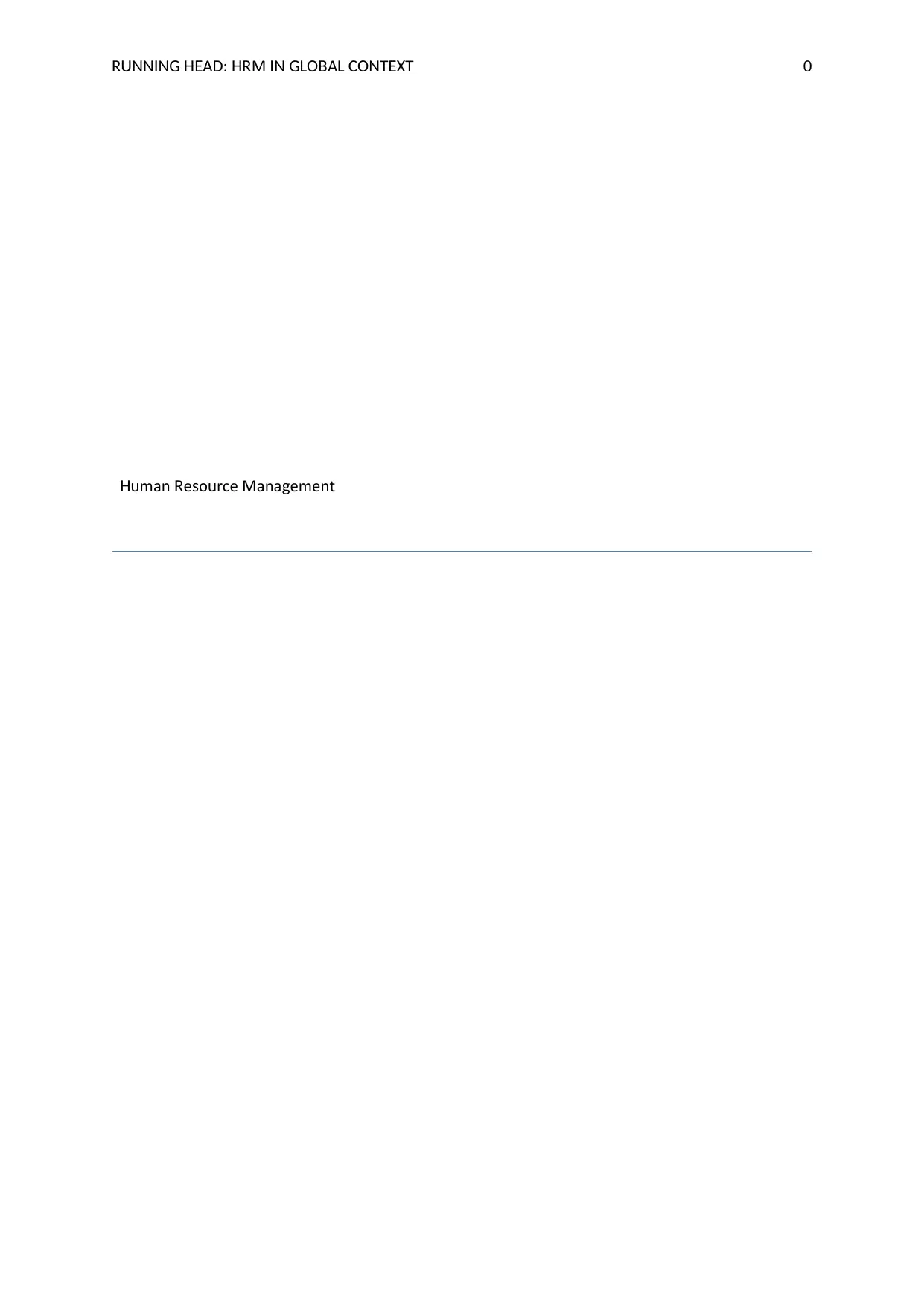
A M A T TRUNNING HE D: HR IN GLOB L CON EX 0
man e o rce Mana ementHu R s u g
man e o rce Mana ementHu R s u g
Paraphrase This Document
Need a fresh take? Get an instant paraphrase of this document with our AI Paraphraser
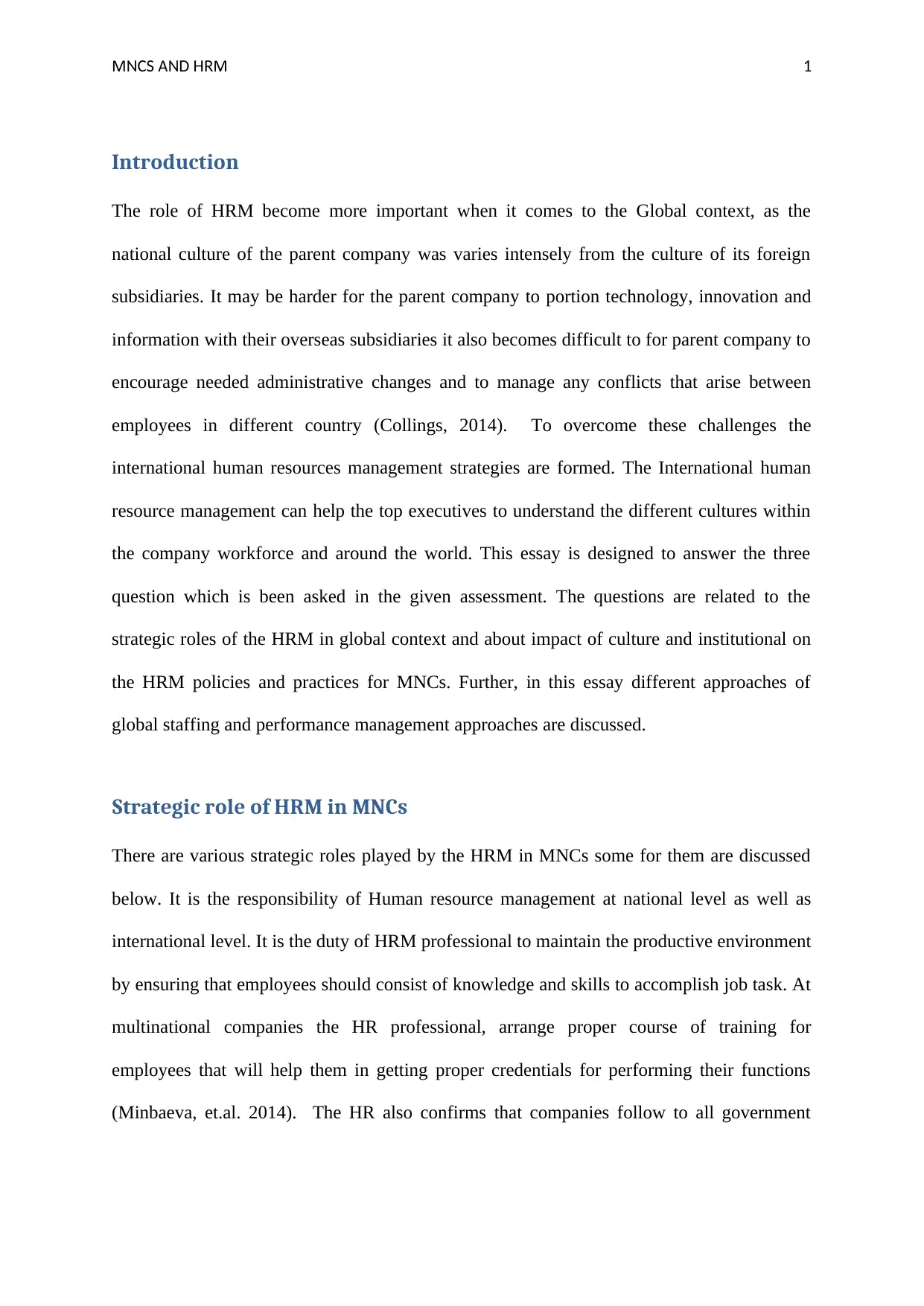
M A MNCS ND HR 1
Introduction
The role of HRM become more important when it comes to the Global context, as the
national culture of the parent company was varies intensely from the culture of its foreign
subsidiaries. It may be harder for the parent company to portion technology, innovation and
information with their overseas subsidiaries it also becomes difficult to for parent company to
encourage needed administrative changes and to manage any conflicts that arise between
employees in different country (Collings, 2014). To overcome these challenges the
international human resources management strategies are formed. The International human
resource management can help the top executives to understand the different cultures within
the company workforce and around the world. This essay is designed to answer the three
question which is been asked in the given assessment. The questions are related to the
strategic roles of the HRM in global context and about impact of culture and institutional on
the HRM policies and practices for MNCs. Further, in this essay different approaches of
global staffing and performance management approaches are discussed.
Strategic role of HRM in MNCs
There are various strategic roles played by the HRM in MNCs some for them are discussed
below. It is the responsibility of Human resource management at national level as well as
international level. It is the duty of HRM professional to maintain the productive environment
by ensuring that employees should consist of knowledge and skills to accomplish job task. At
multinational companies the HR professional, arrange proper course of training for
employees that will help them in getting proper credentials for performing their functions
(Minbaeva, et.al. 2014). The HR also confirms that companies follow to all government
Introduction
The role of HRM become more important when it comes to the Global context, as the
national culture of the parent company was varies intensely from the culture of its foreign
subsidiaries. It may be harder for the parent company to portion technology, innovation and
information with their overseas subsidiaries it also becomes difficult to for parent company to
encourage needed administrative changes and to manage any conflicts that arise between
employees in different country (Collings, 2014). To overcome these challenges the
international human resources management strategies are formed. The International human
resource management can help the top executives to understand the different cultures within
the company workforce and around the world. This essay is designed to answer the three
question which is been asked in the given assessment. The questions are related to the
strategic roles of the HRM in global context and about impact of culture and institutional on
the HRM policies and practices for MNCs. Further, in this essay different approaches of
global staffing and performance management approaches are discussed.
Strategic role of HRM in MNCs
There are various strategic roles played by the HRM in MNCs some for them are discussed
below. It is the responsibility of Human resource management at national level as well as
international level. It is the duty of HRM professional to maintain the productive environment
by ensuring that employees should consist of knowledge and skills to accomplish job task. At
multinational companies the HR professional, arrange proper course of training for
employees that will help them in getting proper credentials for performing their functions
(Minbaeva, et.al. 2014). The HR also confirms that companies follow to all government
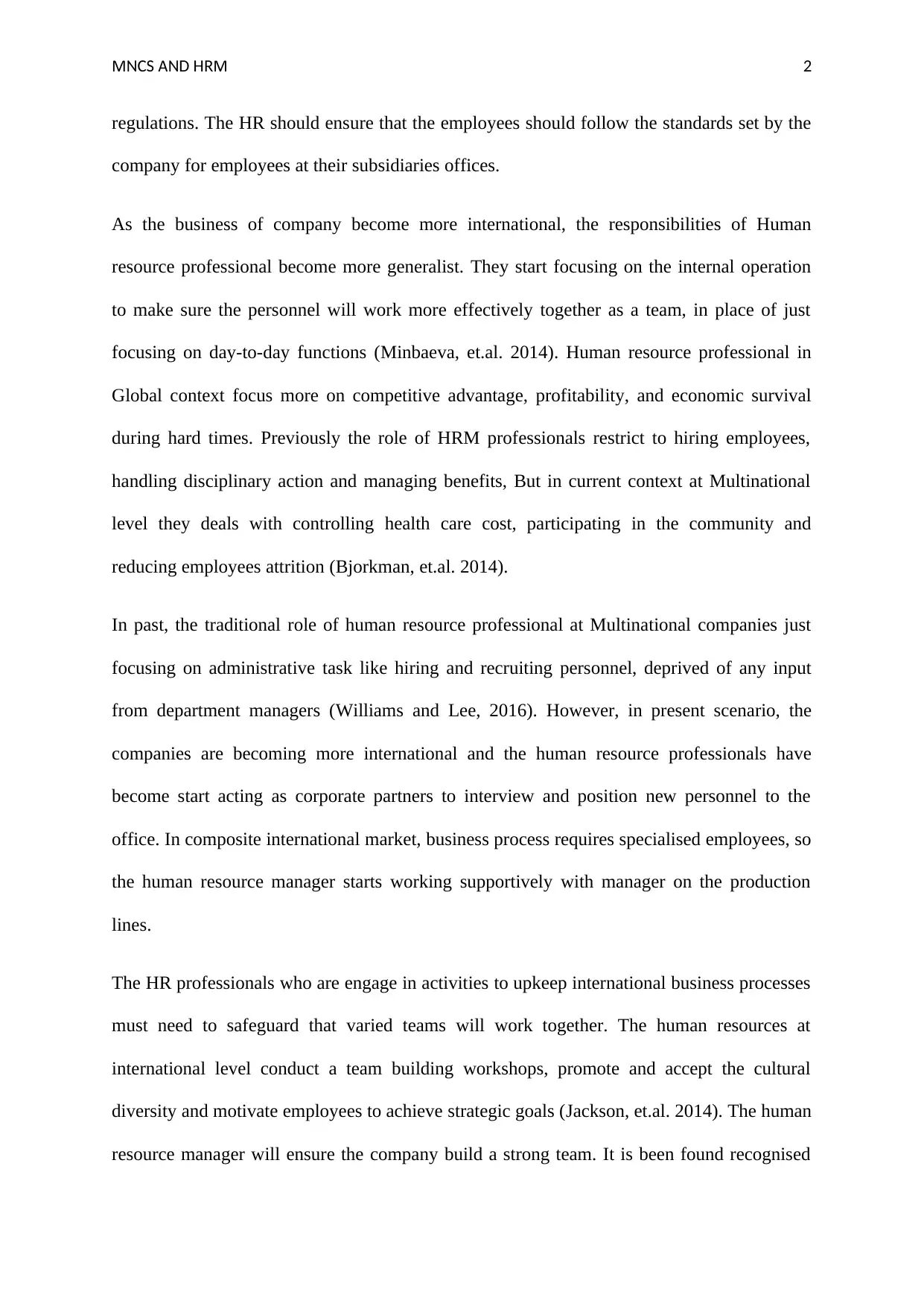
M A MNCS ND HR 2
regulations. The HR should ensure that the employees should follow the standards set by the
company for employees at their subsidiaries offices.
As the business of company become more international, the responsibilities of Human
resource professional become more generalist. They start focusing on the internal operation
to make sure the personnel will work more effectively together as a team, in place of just
focusing on day-to-day functions (Minbaeva, et.al. 2014). Human resource professional in
Global context focus more on competitive advantage, profitability, and economic survival
during hard times. Previously the role of HRM professionals restrict to hiring employees,
handling disciplinary action and managing benefits, But in current context at Multinational
level they deals with controlling health care cost, participating in the community and
reducing employees attrition (Bjorkman, et.al. 2014).
In past, the traditional role of human resource professional at Multinational companies just
focusing on administrative task like hiring and recruiting personnel, deprived of any input
from department managers (Williams and Lee, 2016). However, in present scenario, the
companies are becoming more international and the human resource professionals have
become start acting as corporate partners to interview and position new personnel to the
office. In composite international market, business process requires specialised employees, so
the human resource manager starts working supportively with manager on the production
lines.
The HR professionals who are engage in activities to upkeep international business processes
must need to safeguard that varied teams will work together. The human resources at
international level conduct a team building workshops, promote and accept the cultural
diversity and motivate employees to achieve strategic goals (Jackson, et.al. 2014). The human
resource manager will ensure the company build a strong team. It is been found recognised
regulations. The HR should ensure that the employees should follow the standards set by the
company for employees at their subsidiaries offices.
As the business of company become more international, the responsibilities of Human
resource professional become more generalist. They start focusing on the internal operation
to make sure the personnel will work more effectively together as a team, in place of just
focusing on day-to-day functions (Minbaeva, et.al. 2014). Human resource professional in
Global context focus more on competitive advantage, profitability, and economic survival
during hard times. Previously the role of HRM professionals restrict to hiring employees,
handling disciplinary action and managing benefits, But in current context at Multinational
level they deals with controlling health care cost, participating in the community and
reducing employees attrition (Bjorkman, et.al. 2014).
In past, the traditional role of human resource professional at Multinational companies just
focusing on administrative task like hiring and recruiting personnel, deprived of any input
from department managers (Williams and Lee, 2016). However, in present scenario, the
companies are becoming more international and the human resource professionals have
become start acting as corporate partners to interview and position new personnel to the
office. In composite international market, business process requires specialised employees, so
the human resource manager starts working supportively with manager on the production
lines.
The HR professionals who are engage in activities to upkeep international business processes
must need to safeguard that varied teams will work together. The human resources at
international level conduct a team building workshops, promote and accept the cultural
diversity and motivate employees to achieve strategic goals (Jackson, et.al. 2014). The human
resource manager will ensure the company build a strong team. It is been found recognised
⊘ This is a preview!⊘
Do you want full access?
Subscribe today to unlock all pages.

Trusted by 1+ million students worldwide
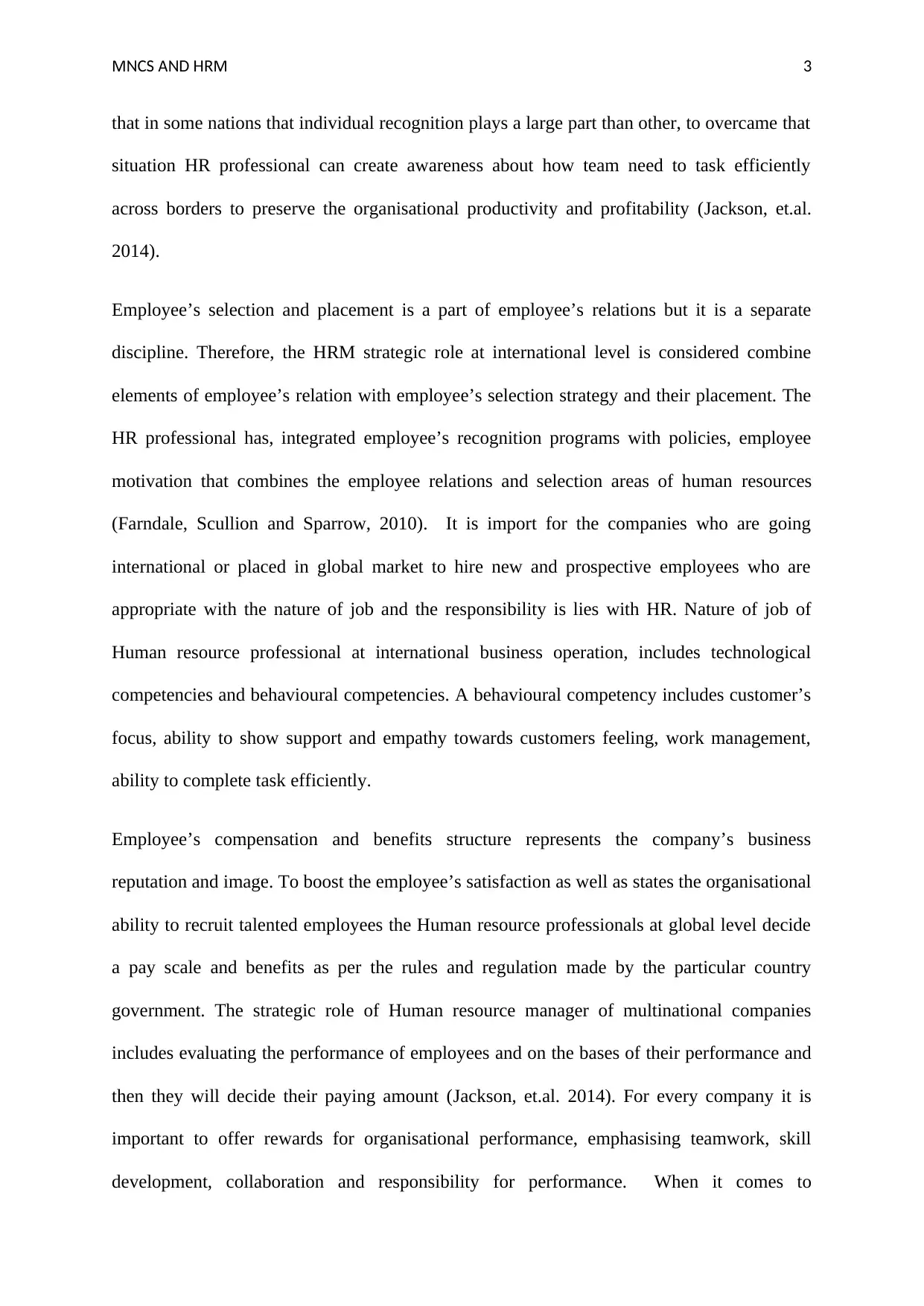
M A MNCS ND HR 3
that in some nations that individual recognition plays a large part than other, to overcame that
situation HR professional can create awareness about how team need to task efficiently
across borders to preserve the organisational productivity and profitability (Jackson, et.al.
2014).
Employee’s selection and placement is a part of employee’s relations but it is a separate
discipline. Therefore, the HRM strategic role at international level is considered combine
elements of employee’s relation with employee’s selection strategy and their placement. The
HR professional has, integrated employee’s recognition programs with policies, employee
motivation that combines the employee relations and selection areas of human resources
(Farndale, Scullion and Sparrow, 2010). It is import for the companies who are going
international or placed in global market to hire new and prospective employees who are
appropriate with the nature of job and the responsibility is lies with HR. Nature of job of
Human resource professional at international business operation, includes technological
competencies and behavioural competencies. A behavioural competency includes customer’s
focus, ability to show support and empathy towards customers feeling, work management,
ability to complete task efficiently.
Employee’s compensation and benefits structure represents the company’s business
reputation and image. To boost the employee’s satisfaction as well as states the organisational
ability to recruit talented employees the Human resource professionals at global level decide
a pay scale and benefits as per the rules and regulation made by the particular country
government. The strategic role of Human resource manager of multinational companies
includes evaluating the performance of employees and on the bases of their performance and
then they will decide their paying amount (Jackson, et.al. 2014). For every company it is
important to offer rewards for organisational performance, emphasising teamwork, skill
development, collaboration and responsibility for performance. When it comes to
that in some nations that individual recognition plays a large part than other, to overcame that
situation HR professional can create awareness about how team need to task efficiently
across borders to preserve the organisational productivity and profitability (Jackson, et.al.
2014).
Employee’s selection and placement is a part of employee’s relations but it is a separate
discipline. Therefore, the HRM strategic role at international level is considered combine
elements of employee’s relation with employee’s selection strategy and their placement. The
HR professional has, integrated employee’s recognition programs with policies, employee
motivation that combines the employee relations and selection areas of human resources
(Farndale, Scullion and Sparrow, 2010). It is import for the companies who are going
international or placed in global market to hire new and prospective employees who are
appropriate with the nature of job and the responsibility is lies with HR. Nature of job of
Human resource professional at international business operation, includes technological
competencies and behavioural competencies. A behavioural competency includes customer’s
focus, ability to show support and empathy towards customers feeling, work management,
ability to complete task efficiently.
Employee’s compensation and benefits structure represents the company’s business
reputation and image. To boost the employee’s satisfaction as well as states the organisational
ability to recruit talented employees the Human resource professionals at global level decide
a pay scale and benefits as per the rules and regulation made by the particular country
government. The strategic role of Human resource manager of multinational companies
includes evaluating the performance of employees and on the bases of their performance and
then they will decide their paying amount (Jackson, et.al. 2014). For every company it is
important to offer rewards for organisational performance, emphasising teamwork, skill
development, collaboration and responsibility for performance. When it comes to
Paraphrase This Document
Need a fresh take? Get an instant paraphrase of this document with our AI Paraphraser
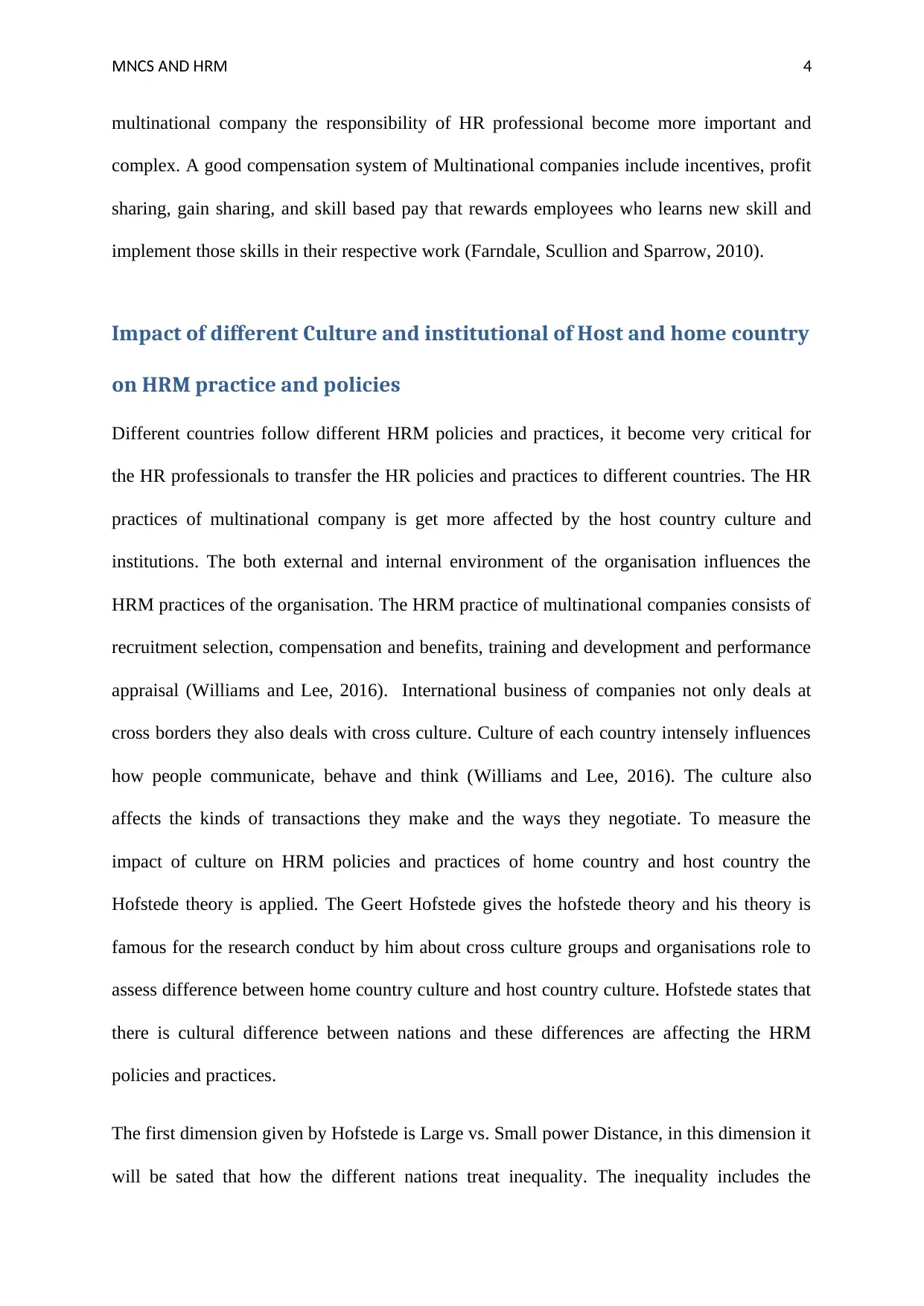
M A MNCS ND HR 4
multinational company the responsibility of HR professional become more important and
complex. A good compensation system of Multinational companies include incentives, profit
sharing, gain sharing, and skill based pay that rewards employees who learns new skill and
implement those skills in their respective work (Farndale, Scullion and Sparrow, 2010).
Impact of different Culture and institutional of Host and home country
on HRM practice and policies
Different countries follow different HRM policies and practices, it become very critical for
the HR professionals to transfer the HR policies and practices to different countries. The HR
practices of multinational company is get more affected by the host country culture and
institutions. The both external and internal environment of the organisation influences the
HRM practices of the organisation. The HRM practice of multinational companies consists of
recruitment selection, compensation and benefits, training and development and performance
appraisal (Williams and Lee, 2016). International business of companies not only deals at
cross borders they also deals with cross culture. Culture of each country intensely influences
how people communicate, behave and think (Williams and Lee, 2016). The culture also
affects the kinds of transactions they make and the ways they negotiate. To measure the
impact of culture on HRM policies and practices of home country and host country the
Hofstede theory is applied. The Geert Hofstede gives the hofstede theory and his theory is
famous for the research conduct by him about cross culture groups and organisations role to
assess difference between home country culture and host country culture. Hofstede states that
there is cultural difference between nations and these differences are affecting the HRM
policies and practices.
The first dimension given by Hofstede is Large vs. Small power Distance, in this dimension it
will be sated that how the different nations treat inequality. The inequality includes the
multinational company the responsibility of HR professional become more important and
complex. A good compensation system of Multinational companies include incentives, profit
sharing, gain sharing, and skill based pay that rewards employees who learns new skill and
implement those skills in their respective work (Farndale, Scullion and Sparrow, 2010).
Impact of different Culture and institutional of Host and home country
on HRM practice and policies
Different countries follow different HRM policies and practices, it become very critical for
the HR professionals to transfer the HR policies and practices to different countries. The HR
practices of multinational company is get more affected by the host country culture and
institutions. The both external and internal environment of the organisation influences the
HRM practices of the organisation. The HRM practice of multinational companies consists of
recruitment selection, compensation and benefits, training and development and performance
appraisal (Williams and Lee, 2016). International business of companies not only deals at
cross borders they also deals with cross culture. Culture of each country intensely influences
how people communicate, behave and think (Williams and Lee, 2016). The culture also
affects the kinds of transactions they make and the ways they negotiate. To measure the
impact of culture on HRM policies and practices of home country and host country the
Hofstede theory is applied. The Geert Hofstede gives the hofstede theory and his theory is
famous for the research conduct by him about cross culture groups and organisations role to
assess difference between home country culture and host country culture. Hofstede states that
there is cultural difference between nations and these differences are affecting the HRM
policies and practices.
The first dimension given by Hofstede is Large vs. Small power Distance, in this dimension it
will be sated that how the different nations treat inequality. The inequality includes the
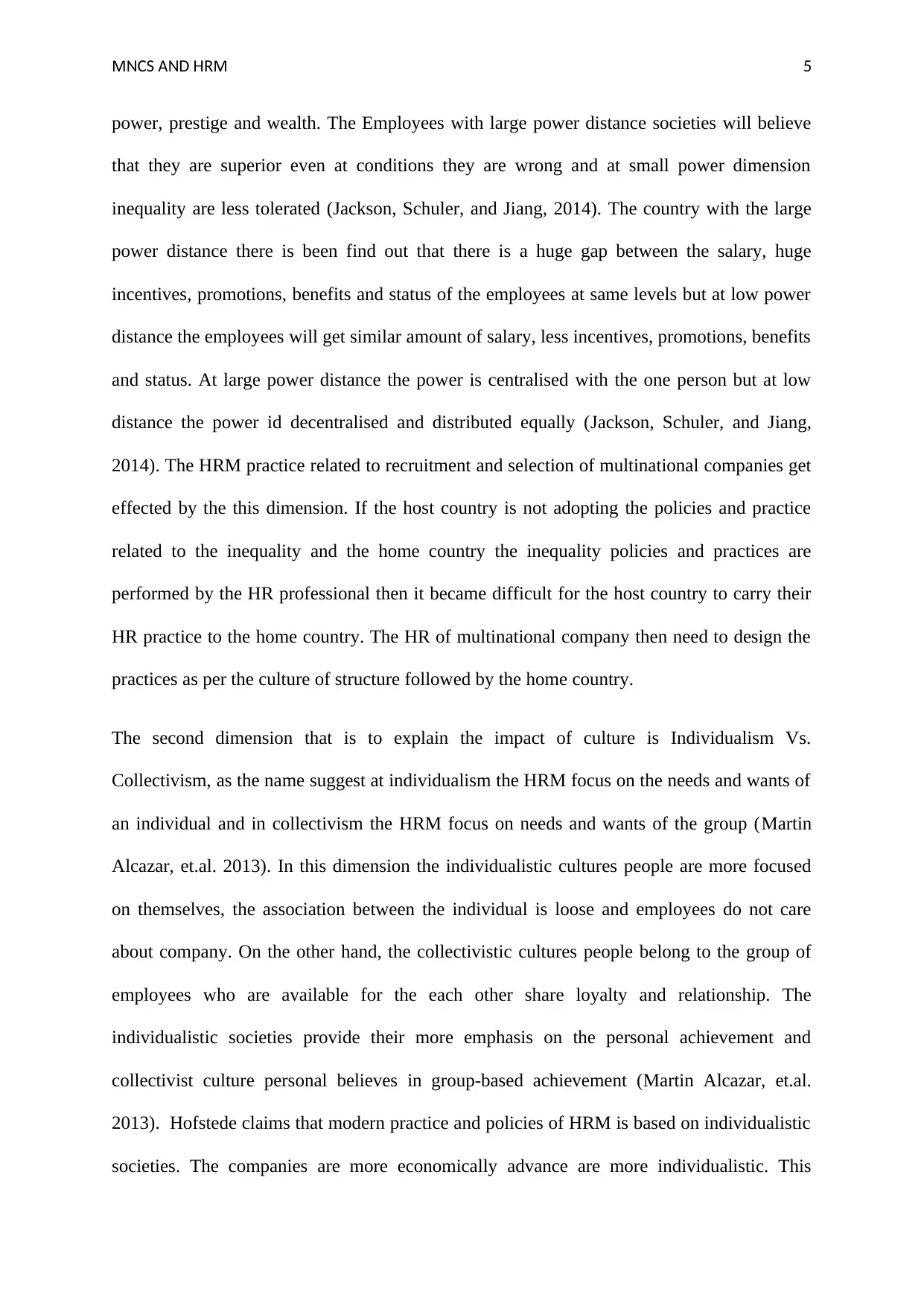
M A MNCS ND HR 5
power, prestige and wealth. The Employees with large power distance societies will believe
that they are superior even at conditions they are wrong and at small power dimension
inequality are less tolerated (Jackson, Schuler, and Jiang, 2014). The country with the large
power distance there is been find out that there is a huge gap between the salary, huge
incentives, promotions, benefits and status of the employees at same levels but at low power
distance the employees will get similar amount of salary, less incentives, promotions, benefits
and status. At large power distance the power is centralised with the one person but at low
distance the power id decentralised and distributed equally (Jackson, Schuler, and Jiang,
2014). The HRM practice related to recruitment and selection of multinational companies get
effected by the this dimension. If the host country is not adopting the policies and practice
related to the inequality and the home country the inequality policies and practices are
performed by the HR professional then it became difficult for the host country to carry their
HR practice to the home country. The HR of multinational company then need to design the
practices as per the culture of structure followed by the home country.
The second dimension that is to explain the impact of culture is Individualism Vs.
Collectivism, as the name suggest at individualism the HRM focus on the needs and wants of
an individual and in collectivism the HRM focus on needs and wants of the group (Martin
Alcazar, et.al. 2013). In this dimension the individualistic cultures people are more focused
on themselves, the association between the individual is loose and employees do not care
about company. On the other hand, the collectivistic cultures people belong to the group of
employees who are available for the each other share loyalty and relationship. The
individualistic societies provide their more emphasis on the personal achievement and
collectivist culture personal believes in group-based achievement (Martin Alcazar, et.al.
2013). Hofstede claims that modern practice and policies of HRM is based on individualistic
societies. The companies are more economically advance are more individualistic. This
power, prestige and wealth. The Employees with large power distance societies will believe
that they are superior even at conditions they are wrong and at small power dimension
inequality are less tolerated (Jackson, Schuler, and Jiang, 2014). The country with the large
power distance there is been find out that there is a huge gap between the salary, huge
incentives, promotions, benefits and status of the employees at same levels but at low power
distance the employees will get similar amount of salary, less incentives, promotions, benefits
and status. At large power distance the power is centralised with the one person but at low
distance the power id decentralised and distributed equally (Jackson, Schuler, and Jiang,
2014). The HRM practice related to recruitment and selection of multinational companies get
effected by the this dimension. If the host country is not adopting the policies and practice
related to the inequality and the home country the inequality policies and practices are
performed by the HR professional then it became difficult for the host country to carry their
HR practice to the home country. The HR of multinational company then need to design the
practices as per the culture of structure followed by the home country.
The second dimension that is to explain the impact of culture is Individualism Vs.
Collectivism, as the name suggest at individualism the HRM focus on the needs and wants of
an individual and in collectivism the HRM focus on needs and wants of the group (Martin
Alcazar, et.al. 2013). In this dimension the individualistic cultures people are more focused
on themselves, the association between the individual is loose and employees do not care
about company. On the other hand, the collectivistic cultures people belong to the group of
employees who are available for the each other share loyalty and relationship. The
individualistic societies provide their more emphasis on the personal achievement and
collectivist culture personal believes in group-based achievement (Martin Alcazar, et.al.
2013). Hofstede claims that modern practice and policies of HRM is based on individualistic
societies. The companies are more economically advance are more individualistic. This
⊘ This is a preview!⊘
Do you want full access?
Subscribe today to unlock all pages.

Trusted by 1+ million students worldwide
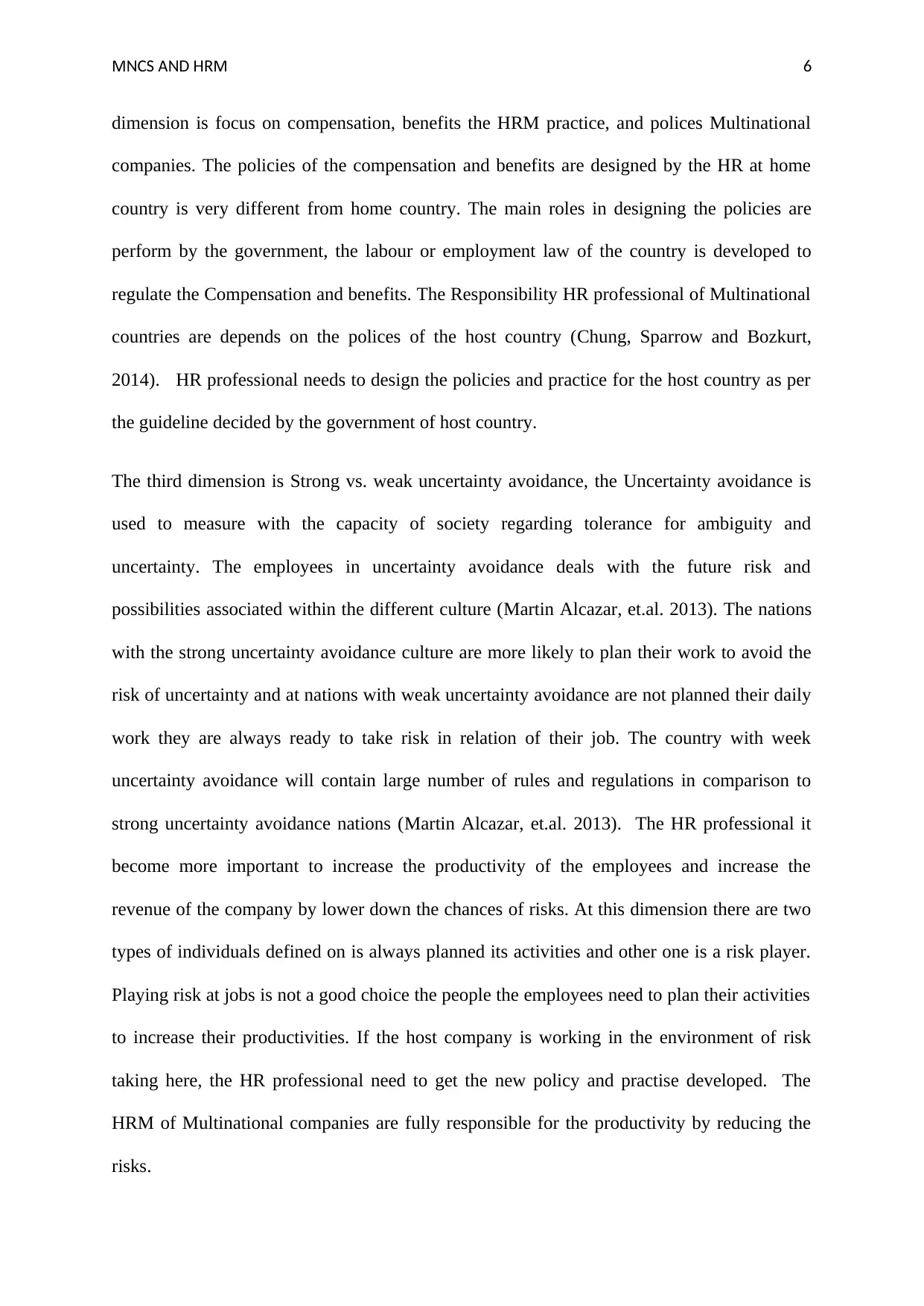
M A MNCS ND HR 6
dimension is focus on compensation, benefits the HRM practice, and polices Multinational
companies. The policies of the compensation and benefits are designed by the HR at home
country is very different from home country. The main roles in designing the policies are
perform by the government, the labour or employment law of the country is developed to
regulate the Compensation and benefits. The Responsibility HR professional of Multinational
countries are depends on the polices of the host country (Chung, Sparrow and Bozkurt,
2014). HR professional needs to design the policies and practice for the host country as per
the guideline decided by the government of host country.
The third dimension is Strong vs. weak uncertainty avoidance, the Uncertainty avoidance is
used to measure with the capacity of society regarding tolerance for ambiguity and
uncertainty. The employees in uncertainty avoidance deals with the future risk and
possibilities associated within the different culture (Martin Alcazar, et.al. 2013). The nations
with the strong uncertainty avoidance culture are more likely to plan their work to avoid the
risk of uncertainty and at nations with weak uncertainty avoidance are not planned their daily
work they are always ready to take risk in relation of their job. The country with week
uncertainty avoidance will contain large number of rules and regulations in comparison to
strong uncertainty avoidance nations (Martin Alcazar, et.al. 2013). The HR professional it
become more important to increase the productivity of the employees and increase the
revenue of the company by lower down the chances of risks. At this dimension there are two
types of individuals defined on is always planned its activities and other one is a risk player.
Playing risk at jobs is not a good choice the people the employees need to plan their activities
to increase their productivities. If the host company is working in the environment of risk
taking here, the HR professional need to get the new policy and practise developed. The
HRM of Multinational companies are fully responsible for the productivity by reducing the
risks.
dimension is focus on compensation, benefits the HRM practice, and polices Multinational
companies. The policies of the compensation and benefits are designed by the HR at home
country is very different from home country. The main roles in designing the policies are
perform by the government, the labour or employment law of the country is developed to
regulate the Compensation and benefits. The Responsibility HR professional of Multinational
countries are depends on the polices of the host country (Chung, Sparrow and Bozkurt,
2014). HR professional needs to design the policies and practice for the host country as per
the guideline decided by the government of host country.
The third dimension is Strong vs. weak uncertainty avoidance, the Uncertainty avoidance is
used to measure with the capacity of society regarding tolerance for ambiguity and
uncertainty. The employees in uncertainty avoidance deals with the future risk and
possibilities associated within the different culture (Martin Alcazar, et.al. 2013). The nations
with the strong uncertainty avoidance culture are more likely to plan their work to avoid the
risk of uncertainty and at nations with weak uncertainty avoidance are not planned their daily
work they are always ready to take risk in relation of their job. The country with week
uncertainty avoidance will contain large number of rules and regulations in comparison to
strong uncertainty avoidance nations (Martin Alcazar, et.al. 2013). The HR professional it
become more important to increase the productivity of the employees and increase the
revenue of the company by lower down the chances of risks. At this dimension there are two
types of individuals defined on is always planned its activities and other one is a risk player.
Playing risk at jobs is not a good choice the people the employees need to plan their activities
to increase their productivities. If the host company is working in the environment of risk
taking here, the HR professional need to get the new policy and practise developed. The
HRM of Multinational companies are fully responsible for the productivity by reducing the
risks.
Paraphrase This Document
Need a fresh take? Get an instant paraphrase of this document with our AI Paraphraser
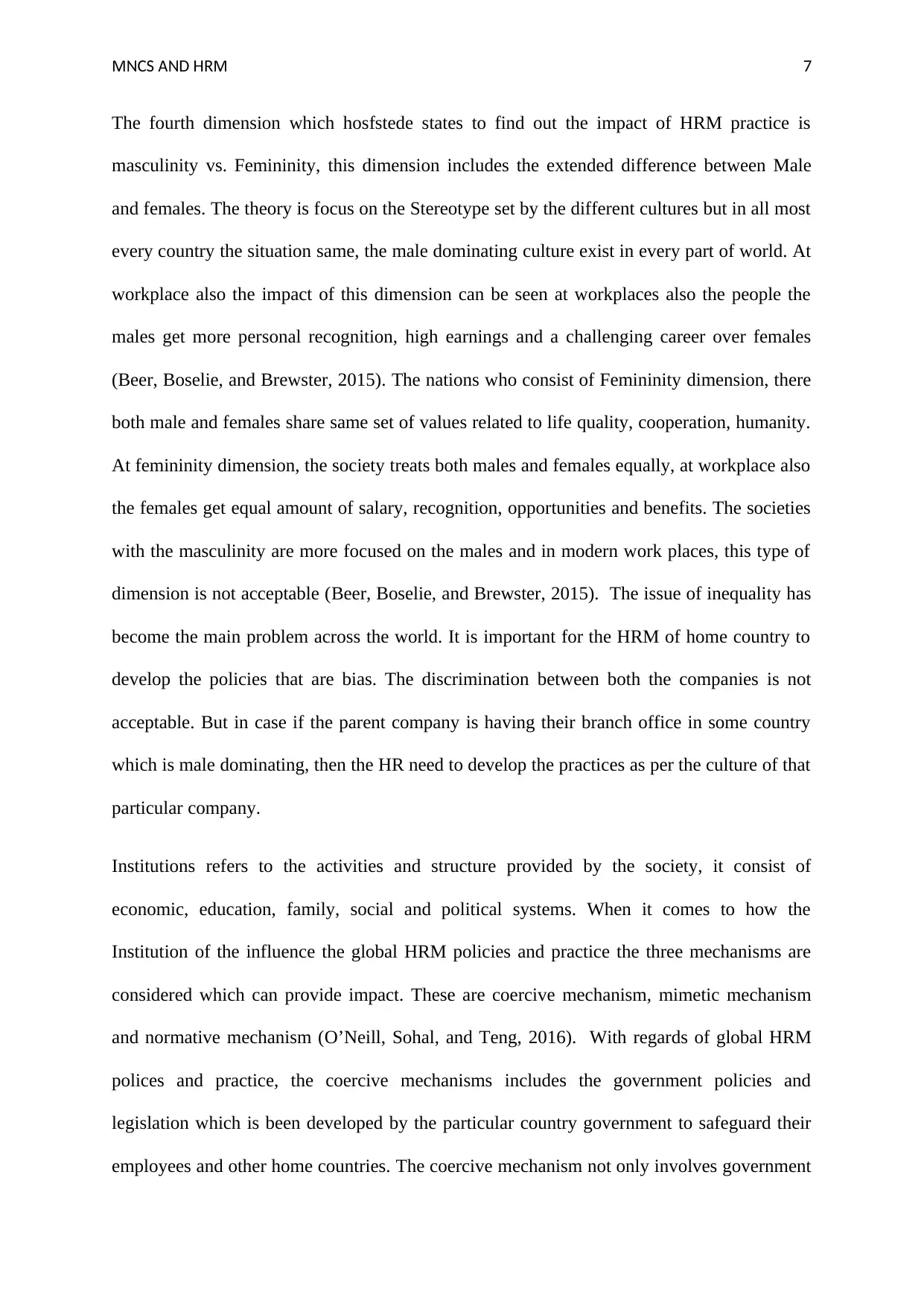
M A MNCS ND HR 7
The fourth dimension which hosfstede states to find out the impact of HRM practice is
masculinity vs. Femininity, this dimension includes the extended difference between Male
and females. The theory is focus on the Stereotype set by the different cultures but in all most
every country the situation same, the male dominating culture exist in every part of world. At
workplace also the impact of this dimension can be seen at workplaces also the people the
males get more personal recognition, high earnings and a challenging career over females
(Beer, Boselie, and Brewster, 2015). The nations who consist of Femininity dimension, there
both male and females share same set of values related to life quality, cooperation, humanity.
At femininity dimension, the society treats both males and females equally, at workplace also
the females get equal amount of salary, recognition, opportunities and benefits. The societies
with the masculinity are more focused on the males and in modern work places, this type of
dimension is not acceptable (Beer, Boselie, and Brewster, 2015). The issue of inequality has
become the main problem across the world. It is important for the HRM of home country to
develop the policies that are bias. The discrimination between both the companies is not
acceptable. But in case if the parent company is having their branch office in some country
which is male dominating, then the HR need to develop the practices as per the culture of that
particular company.
Institutions refers to the activities and structure provided by the society, it consist of
economic, education, family, social and political systems. When it comes to how the
Institution of the influence the global HRM policies and practice the three mechanisms are
considered which can provide impact. These are coercive mechanism, mimetic mechanism
and normative mechanism (O’Neill, Sohal, and Teng, 2016). With regards of global HRM
polices and practice, the coercive mechanisms includes the government policies and
legislation which is been developed by the particular country government to safeguard their
employees and other home countries. The coercive mechanism not only involves government
The fourth dimension which hosfstede states to find out the impact of HRM practice is
masculinity vs. Femininity, this dimension includes the extended difference between Male
and females. The theory is focus on the Stereotype set by the different cultures but in all most
every country the situation same, the male dominating culture exist in every part of world. At
workplace also the impact of this dimension can be seen at workplaces also the people the
males get more personal recognition, high earnings and a challenging career over females
(Beer, Boselie, and Brewster, 2015). The nations who consist of Femininity dimension, there
both male and females share same set of values related to life quality, cooperation, humanity.
At femininity dimension, the society treats both males and females equally, at workplace also
the females get equal amount of salary, recognition, opportunities and benefits. The societies
with the masculinity are more focused on the males and in modern work places, this type of
dimension is not acceptable (Beer, Boselie, and Brewster, 2015). The issue of inequality has
become the main problem across the world. It is important for the HRM of home country to
develop the policies that are bias. The discrimination between both the companies is not
acceptable. But in case if the parent company is having their branch office in some country
which is male dominating, then the HR need to develop the practices as per the culture of that
particular company.
Institutions refers to the activities and structure provided by the society, it consist of
economic, education, family, social and political systems. When it comes to how the
Institution of the influence the global HRM policies and practice the three mechanisms are
considered which can provide impact. These are coercive mechanism, mimetic mechanism
and normative mechanism (O’Neill, Sohal, and Teng, 2016). With regards of global HRM
polices and practice, the coercive mechanisms includes the government policies and
legislation which is been developed by the particular country government to safeguard their
employees and other home countries. The coercive mechanism not only involves government
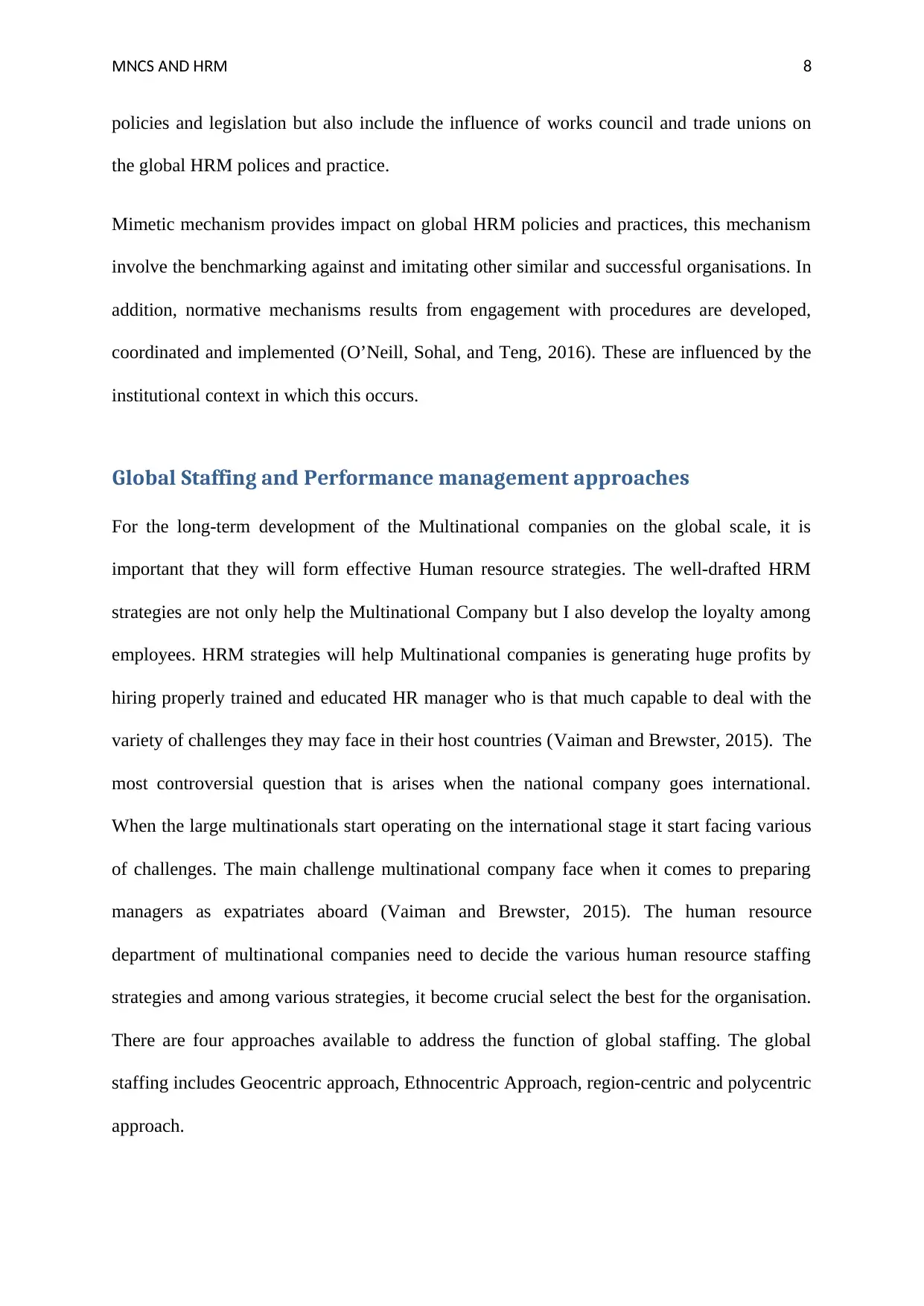
M A MNCS ND HR 8
policies and legislation but also include the influence of works council and trade unions on
the global HRM polices and practice.
Mimetic mechanism provides impact on global HRM policies and practices, this mechanism
involve the benchmarking against and imitating other similar and successful organisations. In
addition, normative mechanisms results from engagement with procedures are developed,
coordinated and implemented (O’Neill, Sohal, and Teng, 2016). These are influenced by the
institutional context in which this occurs.
Global Staffing and Performance management approaches
For the long-term development of the Multinational companies on the global scale, it is
important that they will form effective Human resource strategies. The well-drafted HRM
strategies are not only help the Multinational Company but I also develop the loyalty among
employees. HRM strategies will help Multinational companies is generating huge profits by
hiring properly trained and educated HR manager who is that much capable to deal with the
variety of challenges they may face in their host countries (Vaiman and Brewster, 2015). The
most controversial question that is arises when the national company goes international.
When the large multinationals start operating on the international stage it start facing various
of challenges. The main challenge multinational company face when it comes to preparing
managers as expatriates aboard (Vaiman and Brewster, 2015). The human resource
department of multinational companies need to decide the various human resource staffing
strategies and among various strategies, it become crucial select the best for the organisation.
There are four approaches available to address the function of global staffing. The global
staffing includes Geocentric approach, Ethnocentric Approach, region-centric and polycentric
approach.
policies and legislation but also include the influence of works council and trade unions on
the global HRM polices and practice.
Mimetic mechanism provides impact on global HRM policies and practices, this mechanism
involve the benchmarking against and imitating other similar and successful organisations. In
addition, normative mechanisms results from engagement with procedures are developed,
coordinated and implemented (O’Neill, Sohal, and Teng, 2016). These are influenced by the
institutional context in which this occurs.
Global Staffing and Performance management approaches
For the long-term development of the Multinational companies on the global scale, it is
important that they will form effective Human resource strategies. The well-drafted HRM
strategies are not only help the Multinational Company but I also develop the loyalty among
employees. HRM strategies will help Multinational companies is generating huge profits by
hiring properly trained and educated HR manager who is that much capable to deal with the
variety of challenges they may face in their host countries (Vaiman and Brewster, 2015). The
most controversial question that is arises when the national company goes international.
When the large multinationals start operating on the international stage it start facing various
of challenges. The main challenge multinational company face when it comes to preparing
managers as expatriates aboard (Vaiman and Brewster, 2015). The human resource
department of multinational companies need to decide the various human resource staffing
strategies and among various strategies, it become crucial select the best for the organisation.
There are four approaches available to address the function of global staffing. The global
staffing includes Geocentric approach, Ethnocentric Approach, region-centric and polycentric
approach.
⊘ This is a preview!⊘
Do you want full access?
Subscribe today to unlock all pages.

Trusted by 1+ million students worldwide
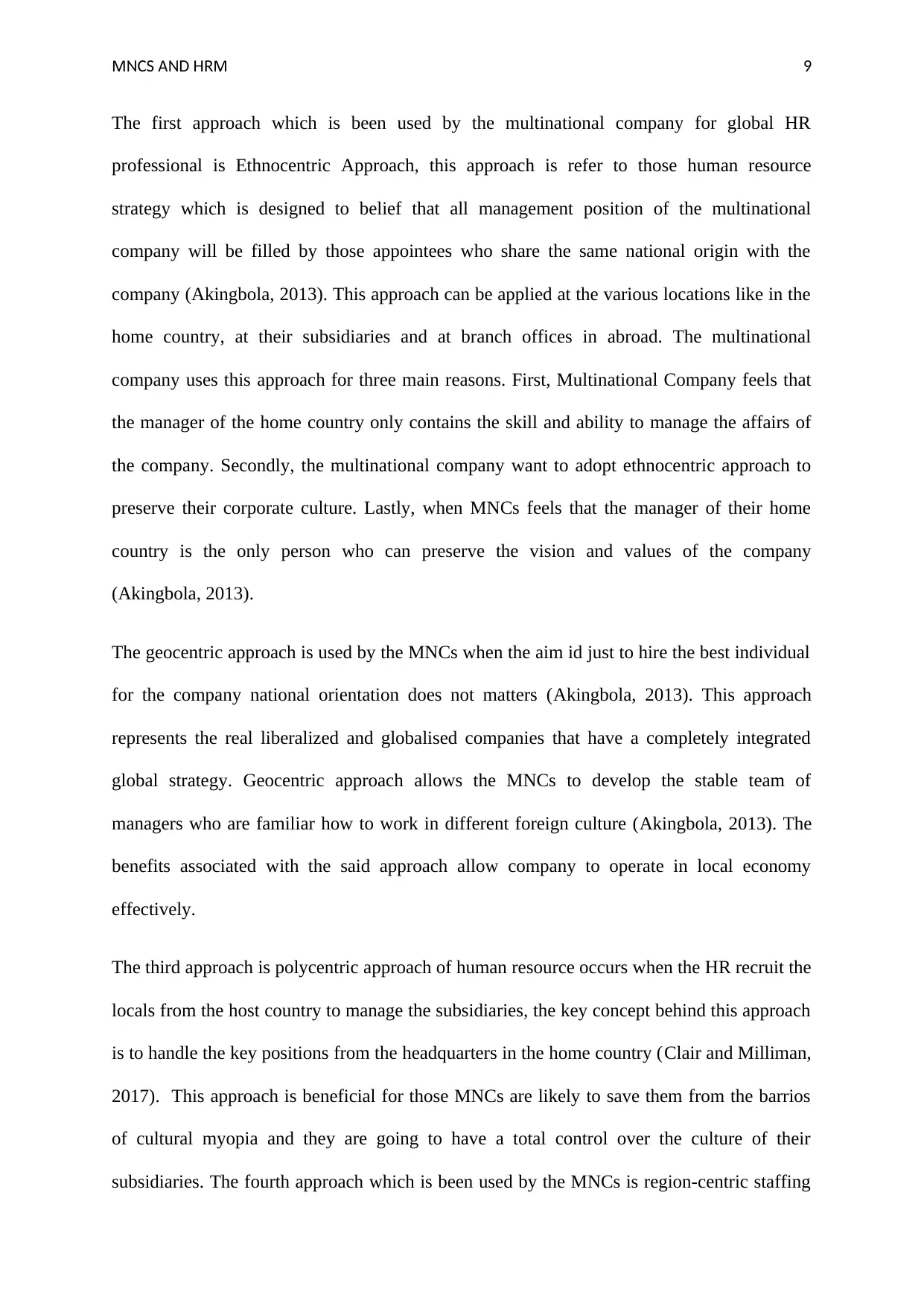
M A MNCS ND HR 9
The first approach which is been used by the multinational company for global HR
professional is Ethnocentric Approach, this approach is refer to those human resource
strategy which is designed to belief that all management position of the multinational
company will be filled by those appointees who share the same national origin with the
company (Akingbola, 2013). This approach can be applied at the various locations like in the
home country, at their subsidiaries and at branch offices in abroad. The multinational
company uses this approach for three main reasons. First, Multinational Company feels that
the manager of the home country only contains the skill and ability to manage the affairs of
the company. Secondly, the multinational company want to adopt ethnocentric approach to
preserve their corporate culture. Lastly, when MNCs feels that the manager of their home
country is the only person who can preserve the vision and values of the company
(Akingbola, 2013).
The geocentric approach is used by the MNCs when the aim id just to hire the best individual
for the company national orientation does not matters (Akingbola, 2013). This approach
represents the real liberalized and globalised companies that have a completely integrated
global strategy. Geocentric approach allows the MNCs to develop the stable team of
managers who are familiar how to work in different foreign culture (Akingbola, 2013). The
benefits associated with the said approach allow company to operate in local economy
effectively.
The third approach is polycentric approach of human resource occurs when the HR recruit the
locals from the host country to manage the subsidiaries, the key concept behind this approach
is to handle the key positions from the headquarters in the home country (Clair and Milliman,
2017). This approach is beneficial for those MNCs are likely to save them from the barrios
of cultural myopia and they are going to have a total control over the culture of their
subsidiaries. The fourth approach which is been used by the MNCs is region-centric staffing
The first approach which is been used by the multinational company for global HR
professional is Ethnocentric Approach, this approach is refer to those human resource
strategy which is designed to belief that all management position of the multinational
company will be filled by those appointees who share the same national origin with the
company (Akingbola, 2013). This approach can be applied at the various locations like in the
home country, at their subsidiaries and at branch offices in abroad. The multinational
company uses this approach for three main reasons. First, Multinational Company feels that
the manager of the home country only contains the skill and ability to manage the affairs of
the company. Secondly, the multinational company want to adopt ethnocentric approach to
preserve their corporate culture. Lastly, when MNCs feels that the manager of their home
country is the only person who can preserve the vision and values of the company
(Akingbola, 2013).
The geocentric approach is used by the MNCs when the aim id just to hire the best individual
for the company national orientation does not matters (Akingbola, 2013). This approach
represents the real liberalized and globalised companies that have a completely integrated
global strategy. Geocentric approach allows the MNCs to develop the stable team of
managers who are familiar how to work in different foreign culture (Akingbola, 2013). The
benefits associated with the said approach allow company to operate in local economy
effectively.
The third approach is polycentric approach of human resource occurs when the HR recruit the
locals from the host country to manage the subsidiaries, the key concept behind this approach
is to handle the key positions from the headquarters in the home country (Clair and Milliman,
2017). This approach is beneficial for those MNCs are likely to save them from the barrios
of cultural myopia and they are going to have a total control over the culture of their
subsidiaries. The fourth approach which is been used by the MNCs is region-centric staffing
Paraphrase This Document
Need a fresh take? Get an instant paraphrase of this document with our AI Paraphraser
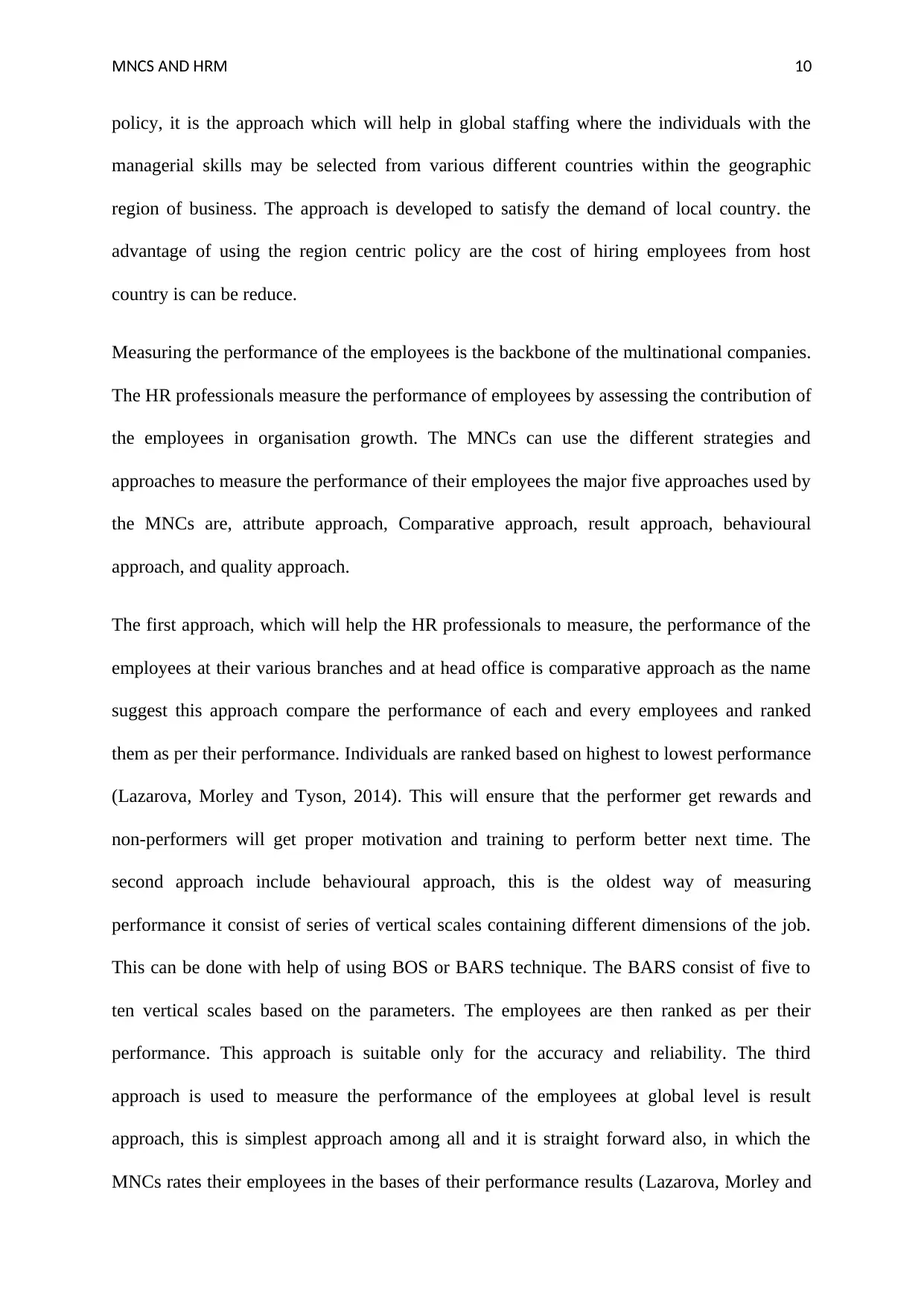
M A MNCS ND HR 10
policy, it is the approach which will help in global staffing where the individuals with the
managerial skills may be selected from various different countries within the geographic
region of business. The approach is developed to satisfy the demand of local country. the
advantage of using the region centric policy are the cost of hiring employees from host
country is can be reduce.
Measuring the performance of the employees is the backbone of the multinational companies.
The HR professionals measure the performance of employees by assessing the contribution of
the employees in organisation growth. The MNCs can use the different strategies and
approaches to measure the performance of their employees the major five approaches used by
the MNCs are, attribute approach, Comparative approach, result approach, behavioural
approach, and quality approach.
The first approach, which will help the HR professionals to measure, the performance of the
employees at their various branches and at head office is comparative approach as the name
suggest this approach compare the performance of each and every employees and ranked
them as per their performance. Individuals are ranked based on highest to lowest performance
(Lazarova, Morley and Tyson, 2014). This will ensure that the performer get rewards and
non-performers will get proper motivation and training to perform better next time. The
second approach include behavioural approach, this is the oldest way of measuring
performance it consist of series of vertical scales containing different dimensions of the job.
This can be done with help of using BOS or BARS technique. The BARS consist of five to
ten vertical scales based on the parameters. The employees are then ranked as per their
performance. This approach is suitable only for the accuracy and reliability. The third
approach is used to measure the performance of the employees at global level is result
approach, this is simplest approach among all and it is straight forward also, in which the
MNCs rates their employees in the bases of their performance results (Lazarova, Morley and
policy, it is the approach which will help in global staffing where the individuals with the
managerial skills may be selected from various different countries within the geographic
region of business. The approach is developed to satisfy the demand of local country. the
advantage of using the region centric policy are the cost of hiring employees from host
country is can be reduce.
Measuring the performance of the employees is the backbone of the multinational companies.
The HR professionals measure the performance of employees by assessing the contribution of
the employees in organisation growth. The MNCs can use the different strategies and
approaches to measure the performance of their employees the major five approaches used by
the MNCs are, attribute approach, Comparative approach, result approach, behavioural
approach, and quality approach.
The first approach, which will help the HR professionals to measure, the performance of the
employees at their various branches and at head office is comparative approach as the name
suggest this approach compare the performance of each and every employees and ranked
them as per their performance. Individuals are ranked based on highest to lowest performance
(Lazarova, Morley and Tyson, 2014). This will ensure that the performer get rewards and
non-performers will get proper motivation and training to perform better next time. The
second approach include behavioural approach, this is the oldest way of measuring
performance it consist of series of vertical scales containing different dimensions of the job.
This can be done with help of using BOS or BARS technique. The BARS consist of five to
ten vertical scales based on the parameters. The employees are then ranked as per their
performance. This approach is suitable only for the accuracy and reliability. The third
approach is used to measure the performance of the employees at global level is result
approach, this is simplest approach among all and it is straight forward also, in which the
MNCs rates their employees in the bases of their performance results (Lazarova, Morley and
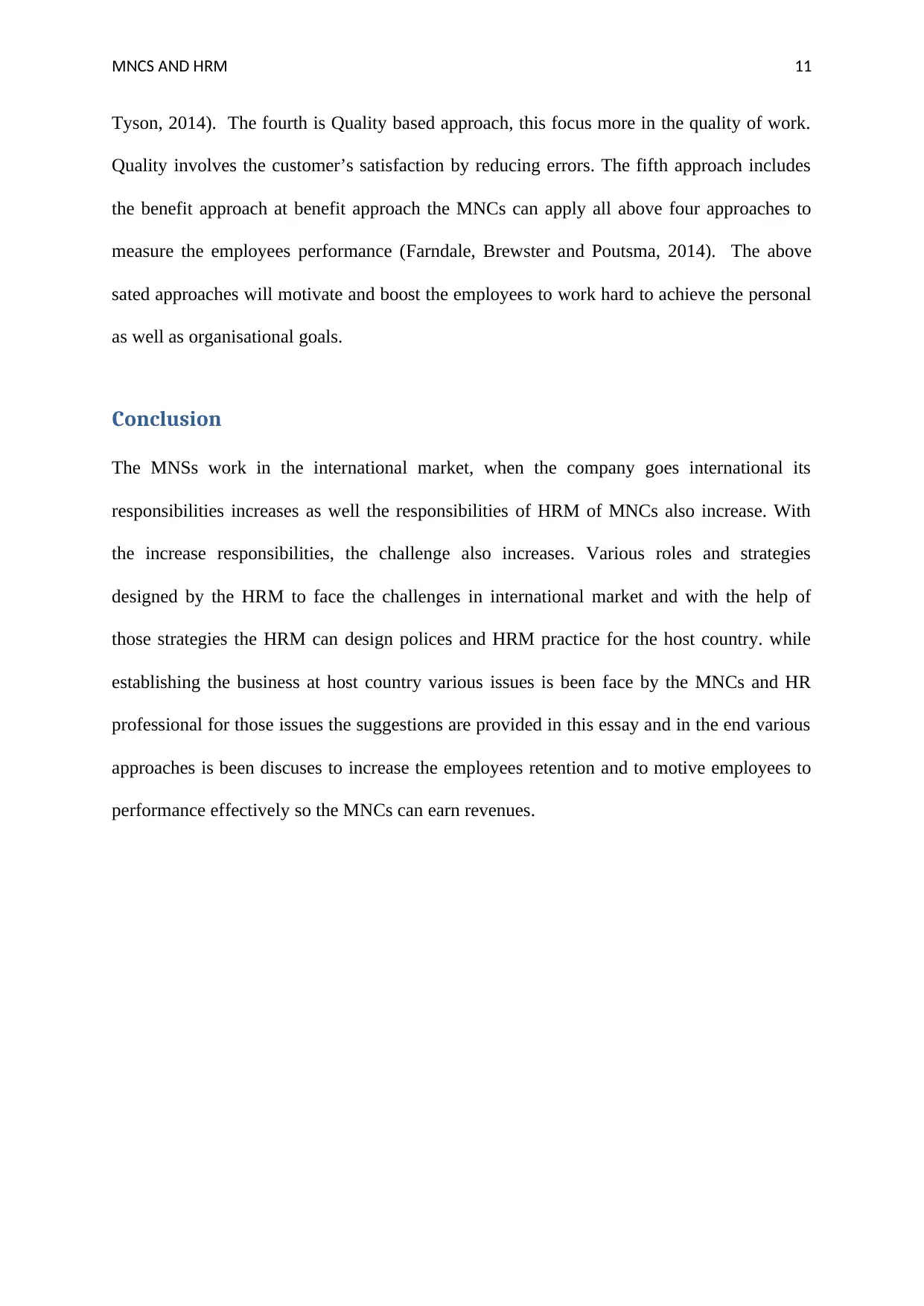
M A MNCS ND HR 11
Tyson, 2014). The fourth is Quality based approach, this focus more in the quality of work.
Quality involves the customer’s satisfaction by reducing errors. The fifth approach includes
the benefit approach at benefit approach the MNCs can apply all above four approaches to
measure the employees performance (Farndale, Brewster and Poutsma, 2014). The above
sated approaches will motivate and boost the employees to work hard to achieve the personal
as well as organisational goals.
Conclusion
The MNSs work in the international market, when the company goes international its
responsibilities increases as well the responsibilities of HRM of MNCs also increase. With
the increase responsibilities, the challenge also increases. Various roles and strategies
designed by the HRM to face the challenges in international market and with the help of
those strategies the HRM can design polices and HRM practice for the host country. while
establishing the business at host country various issues is been face by the MNCs and HR
professional for those issues the suggestions are provided in this essay and in the end various
approaches is been discuses to increase the employees retention and to motive employees to
performance effectively so the MNCs can earn revenues.
Tyson, 2014). The fourth is Quality based approach, this focus more in the quality of work.
Quality involves the customer’s satisfaction by reducing errors. The fifth approach includes
the benefit approach at benefit approach the MNCs can apply all above four approaches to
measure the employees performance (Farndale, Brewster and Poutsma, 2014). The above
sated approaches will motivate and boost the employees to work hard to achieve the personal
as well as organisational goals.
Conclusion
The MNSs work in the international market, when the company goes international its
responsibilities increases as well the responsibilities of HRM of MNCs also increase. With
the increase responsibilities, the challenge also increases. Various roles and strategies
designed by the HRM to face the challenges in international market and with the help of
those strategies the HRM can design polices and HRM practice for the host country. while
establishing the business at host country various issues is been face by the MNCs and HR
professional for those issues the suggestions are provided in this essay and in the end various
approaches is been discuses to increase the employees retention and to motive employees to
performance effectively so the MNCs can earn revenues.
⊘ This is a preview!⊘
Do you want full access?
Subscribe today to unlock all pages.

Trusted by 1+ million students worldwide
1 out of 15
Related Documents
Your All-in-One AI-Powered Toolkit for Academic Success.
+13062052269
info@desklib.com
Available 24*7 on WhatsApp / Email
![[object Object]](/_next/static/media/star-bottom.7253800d.svg)
Unlock your academic potential
Copyright © 2020–2025 A2Z Services. All Rights Reserved. Developed and managed by ZUCOL.




